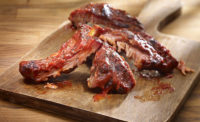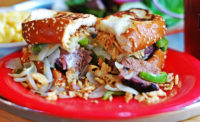Formulation Strategies | Barbecue Trends
A new spin on barbecue
Classic preparation method expands reach in non-traditional areas and flavors.






Barbecue was found on 59.1 percent of restaurant menus in 2018, which is up 1 percent since 2014 and flat from the previous year, according to Chicago-based Datassential’s BBQ, the SNAP Food Profile, created Jan. 23, 2019. Originally used as a sauce to flavor meat at barbecue restaurants, many different varieties of barbecue exist today, ranging from sweet to sour to spicy and appearing on a multitude of proteins. Given barbecue’s prevalence, 97 percent of people know it, 92 percent have tried it and 78 percent love or like it, Datassential reports.
Technomic, a Winsight Co. in Chicago, reports in terms of the number of menu items at chain and independent restaurants, barbecue dishes are largely either stable or showing small declines.
“The decline aligns with overall declines as operators streamline menus,” explains Anne Mills, Technomic’s senior manager of consumer insights.
Barbecue is growing through the expansion of some barbecue concept restaurants though. Mission BBQ, in Glen Burnie, Md., is one of the fastest growing limited-service restaurants in the Top 500, Technomic reports. While the research firm doesn’t have 2018 numbers yet, the chain grew unit count 33 percent to 56 U.S. units in 2017.
Regionally, barbecue is featured on 65.2 percent of restaurant menus in the Midwest, followed by the South with 60.1 percent, Northeast with 59 percent and West with 66.9 percent, Datassential reports. As far as restaurant types, barbecue is growing the fastest on burger, Japanese, sandwich, pizza and steakhouse menus, says Kelley Fechner, Datassential’s director of customer solutions.
In regard to cuts of meat mentioned with barbecue, Datassential reports pork belly, pork shoulder and brisket are growing on menus. Technomic reports pulled pork is growing on Top 500 operator menus versus two years ago. Mintel International, in Chicago, also sees barbecue chicken wings have grown 24 percent on U.S. menus, as tracked by Mintel’s Menu Insights between fourth quarter 2015 and fourth quarter 2018. Barbecue pizza has grown 52 percent on U.S. menus during the same time period, Mintel reports.
In terms of barbecue flavors and styles, Korean, bourbon, Kansas City, Carolina and honey barbecue styles are growing on menus, Datassential says. Technomic shows honey barbecue as well as Latin American flavors are growing for barbecue dishes.
In restaurants, one trend Technomic is seeing for beef and pork in general is larger, shareable portions.
“Barbecue restaurants are also promoting bigger platters featuring several varieties of smoked beef brisket, pork and other meats for dining parties to share,” Mills says. “One example of this is Jack Stack Barbecue. The restaurant offers several platter options, including the Kansas City Combo, which allows guests to build their own platter from among burnt ends, pulled pork, sliced meat, pork spare ribs, beef ribs, lamb ribs and barbecued chicken.”
Another trend is underutilized cuts, including burnt ends, increasingly featured in the center of the plate, Mills says. Spare ribs also are growing on restaurant menus.
Growing turkey and barbecue
With the growth of at-home outdoor cooking, whether it’s smoking or grilling, the National Turkey Federation (NTF), in Washington, D.C., is working to increase demand for barbecued turkey.
“Turkey really lends itself well to barbecue because a lot of people are interested in those bold flavors and turkey can definitely deliver that,” says Beth Breeding, NTF’s vice president of communications and marketing.
With growing demand for protein, turkey also stands to benefit as a leaner cut.
For the past two years, NTF has partnered with professional pit masters and regional contests across the country to promote barbecue turkey to help introduce it to more consumers at home. For example, NTF has conducted a turkey-smoking competition at the American Royal World Series of Barbecue in Kansas City, Mo., the largest barbecue competition in the world.
“That was the first time they ever allowed an outside protein into the competition, so we’re really encouraged by that and by the amount of participation,” Breeding says.
This year, NTF kicked off its barbecue season with a turkey smoke-off at its annual convention in San Antonio. The federation also is expanding its smoking contests across the country at some of the biggest barbecue competitions in the country, including World Championship Barbecue Cooking Contest in Memphis; the American Royal; the Giant National Capital Barbecue Battle in Washington, D.C.; and the 2019 Barbeque Bash in Kansas City, Mo., with the National Barbecuing and Grilling Association. NTF also is joining the Great American Cookout Tour with the Kansas City Barbeque Society.
At these events, NTF will be promoting the versatility of barbecued turkey breast lobes, wings and thighs.
“Our goal would be that we would create our own trend and show people everything that turkey can do,” Breeding says. “I really do think that interest in barbecue is going to continue to grow both for people who were doing it as a hobby as well as the overall larger industry. Introducing different proteins like turkey to the mix will only help barbecue continue to grow and capture more interest from consumers.”
Barbecue at home
Consumers continue to enjoy barbecue and grilling beyond the traditional summer holidays and weekend cookouts, so processors such as Smithfield Foods, in Smithfield, Va., continue to expand the breadth of product offerings to meet the need for new and interesting flavors as well as quality and convenience. For example, with consumers’ limited time to prepare a meal, the marinated fresh pork category is growing, with dollar sales up 5 percent and volume up 2 percent, according to Nielsen Perishables Group, Chicago, for the 52 weeks ending Nov. 24, 2018.
“… At-home cooks are looking for conveniently pre-seasoned, versatile proteins such as pork chops or loin filets that can easily and quickly be grilled whole, sliced or cubed for a fast, flavorful weeknight meal,” says Emily Detwiler, Smithfield’s director of fresh pork marketing. “In fact, Smithfield Marinated Fresh Pork is the No. 1 brand in the category with a 35 percent dollar share, with total sales up 5 percent and volume up 3 percent.”
“In addition to the quality and flavor of the products they choose, consumers are looking for ease and convenience more than anything,” Detwiler says. “We understand this consumer demand and strive to produce high-quality fresh pork products that are flavorful and versatile, in packaging sizes that are more conducive to at-home cooks like our half rack of Dry Seasoned Ribs and individually packed pre-seasoned Pork Chops. This is also why our Smithfield Marinated Fresh Pork products have seen such tremendous growth. With little to no prep work, these products are available in wide variety of cuts and flavors and ready to throw on the grill, so consumers can achieve a delicious meal in a matter of minutes.”
Another overall trend is consumers seeking clean labels and “better-for-you” products, as well as more information and transparency about the products they consume.
“They are further educating themselves beyond the ‘natural’ and ‘organic’ claims that are predominant across product packaging,” Detwiler says. “At Smithfield, we are actively informing consumers of the nutritional benefits of fresh pork by adding bursts on labels, so they can easily identify the amount of protein offered per serving and trust that our products have no artificial ingredients, added hormones or steroids.”
Smithfield also continues to see a strong growth in “competition-style” barbecue cuts as consumers are looking to achieve pit master-quality barbecue from their own backyards across a wide variety of styles and flavors. For example, pork ribs and butts/shoulders have delivered 16 million pounds of growth over the past year, with volume up 4.7 percent and 1.3 percent, respectively, in the 52 weeks ended July 28, 2018, according to Nielsen Perishables Group.
Regionality also continues to be popular among consumers, which is why Smithfield offers its Dry Seasoned Ribs in flavors such as Carolina, Memphis and Kansas City Style barbecue in both full and half racks, Detwiler says. With the significant growth in the marinated fresh pork grilling category, Smithfield also offers a line of Dry Seasoned Fresh Pork Chops that are grill-ready in flavors including Hickory Smoked Brown Sugar and Roasted Garlic and Herb.
Smithfield plans to expand its Marinated Fresh Pork offerings further with the introduction of Smithfield Marinated Fresh Pork Strips later this year. The new Marinated Fresh Pork Strips come in a variety of flavors, including Sweet Teriyaki, Korean BBQ and Fajita Seasoned, making them suitable for quick-and-easy recipes such as lettuce wraps, fajitas and stir-fry. “These fresh pork strips are hand cut, pre-seasoned, and include a finishing sauce to elevate the eating experience and deliver amazing flavor in just 10 minutes,” Detwiler says.
Given the significant growth of the barbecue industry, Smithfield sees consumers continuing to familiarize themselves with competition-style cuts. In addition, during the last 10 years, the number of competition cook teams has more than doubled, and Smithfield continues to be an investor in the growing sport of competition barbecue with its Smokin’ With Smithfield Committed Cooks and Grant programs. “We hope that our partnerships with leading World Champion pit masters will inspire backyard barbecuers to get grilling with fresh pork,” Detwiler says.
Smithfield also is launching the Smokin’ With Smithfield National Barbecue Championship in 2019. It’s the first unified points chase open to all pit masters and cook teams across the country, designed to level the playing field across all major sanctioning bodies and events. Teams can register at SmokinWithSmithfield.com. The top 24 teams will face off in a three-round, single-elimination playoff contest in New Orleans later this year for the chance to take home the title of National Barbecue Champion along with a piece of the $50,000 cash prize pool.
Barbecue innovation
Mintel also sees diners’ interest in barbecue continue to rise, and restaurants are catering to this by offering more innovative barbecue dishes.
“While the barbecue category heats up in summer with restaurants offering (limited-time offerings), operators are increasingly including barbecue dishes on their menus year round, using it as a condiment on burgers, marinade for pulled chicken and pork and a dressing on indulgent salads,” says Hannah Spencer, Mintel’s foodservice analyst.
As far as flavor innovation, white barbecue sauce experienced 125 percent growth as an ingredient on U.S. menus tracked by Mintel’s Menu Insights between fourth quarter 2015 and fourth quarter 2018. Korean barbecue sauce experienced 28 percent growth as an ingredient on U.S. menus during the same time period.
“Much of this growth is coming from chicken wings prepared with Korean barbecue sauce,” Spencer says.
For example, in May 2018, Buffalo Wild Wings, which is based in Minneapolis, introduced a Korean barbecue limited-time offering to its menu, describing the sauce as a complex blend of soy sauce, red chili pepper, rice vinegar and a bite of garlic.
“The versatility of chicken offers an excellent canvas for chefs to add unique and innovative flavors including barbecue,” Spencer says. “Looking to 2019 and beyond, operators should consider how to add their spin on the classic preparation method or sauce.”
For example, Maryville, Tenn.-based Ruby Tuesday’s Carolina Gold BBQ Chicken Wing appetizer is served with pork rinds and crispy barbecue crumbs.
“Operators should leverage the familiarity of barbecue to make introducing new spices such as sriracha, jalapeño and sweet chili less intimidating for diners,” Spencer says. “Chicken wings are a particularly good dish for experimentation with new flavor profiles, [since] chicken wings have the added bonus of already being a popular classic familiar to diners.”
Lee Howard, co-founder of Urban Bar-B-Que, in Annapolis, Md., sees more new flavors coming out of non-traditional barbecue regions such as Washington, D.C., and Chicago, over traditional barbecue regions.
“Barbecue embraces a lot of flavors of the world, different spices, different kinds of twists on sauces, and different flavor profiles that pair great with smoked meat whether it’s chicken or pork or beef,” he says.
Urban Bar-B-Que, whose restaurants are located in nontraditional barbecue areas, features a Carolina-style pulled pork and pulled chicken, Texas-style beef brisket and Memphis-style ribs.
“We picked and chose what we like from each area and came up with our own style,” Howard says. “D.C. is such a transient area. There’s a lot of people from Texas and people from Carolina, but you couldn’t just zero in on one little area like that in this area and be successful.”
With restaurants heavily driven by market prices, popular cuts of meat and poultry for barbecue in restaurants also are price driven. “There is no substitute for a lot of the cuts,” Howard adds.
Pork remains Urban Bar-B-Que’s top seller and brisket it’s No. 2, but since the chain has added tacos, featuring beef brisket, pulled pork, pulled chicken or smoked turkey, last year, the menu item has skyrocketed.
“It allows people to add just a little bit of different flair and different flavor profile to the smoked meats,” Howard says.
Operators also are innovating by combining barbecue with other foods. For example, Erbert and Gerbert’s Sandwich Shop, in Eau Claire, Wis., debuted a Mac and Cheese BBQ Brisket Sandwich, a limited-time sandwich featuring a layer of the chain’s Mac and Cheese topped with barbecue brisket and citrus chipotle barbecue sauce on a choice of bread. Linger, in Denver, also offers Korean BBQ Tacos, featuring wagyu short rib, long bean slaw, radish, wasabi peas, gochujang aioli, ginger and lime.
Additionally, more unique meats such as bison and pork belly are being served with barbecue sauce, Technomic’s Mills says.
Dave and Busters, based in Dallas, introduced Smashed Bar Burgers and Smokehouse Ribs, featuring four smashed sliders and St. Louis-style pork ribs slow-cooked and basted in honey bourbon barbecue sauce. “This highlights the introduction of new and different flavors,” Datassential’s Fechner.
For chicken dishes, growing ingredients speak to complex flavor profiles and ethnic inspirations, Mills explains. “For example, the spicy chicken trend has led to items that balance heat with sweetness, such as KFC’s Hot Honey Extra Crispy Chicken,” she says. “Likewise, growing interest in global flavors is allowing for dishes that incorporate ethnic yet still familiar ingredients like pineapples, salsa and teriyaki sauce.”
KFC, in Louisville, Ky., also continues to innovate with barbecue and last year released Georgia Gold Extra Crispy Tenders, featuring its new Georgia Gold Chicken with honey mustard barbecue sauce.
Growing barbecue
Barbecue is in the ubiquity stage, or mature stage, of Datassential’s Menu Adoption Cycle, the research firm’s predictable journey tool for food trends’ common lifecycles. To keep barbecue growing, Datassential’s Fechner says barbecue should be paired with items or flavors in the adoption or inception stages.
“Build your own platter works really well, in general, for consumers,” Fechner says. “Barbecue fits well into the type of meal, so it helps with consumers’ satisfaction.”
Moving forward, Technomic’s Mills thinks we’ll continue to see flavor innovation. For example, recently Lucille’s Smokehouse Bar-B-Que, in Signal Hills, Calif., debuted Apple Butter BBQ Sauce.
As focus on real ingredients continues, expect more transparency around better-for-you attributes for barbecue as well, Mills says. “As plant-based proteins grow, we could see more barbecue dishes featuring plant-based proteins,” she says.
Urban Bar-B-Que’s Howard also thinks more barbecue places will begin to focus on the fact they are a healthier alternative to traditional fast food.
“Barbecue is really a very lean protein, whether it’s pork, chicken or beef,” he says. “If you look at it versus other fast food, or quick serve food, it is a nice option health wise.” NP
Looking for a reprint of this article?
From high-res PDFs to custom plaques, order your copy today!











